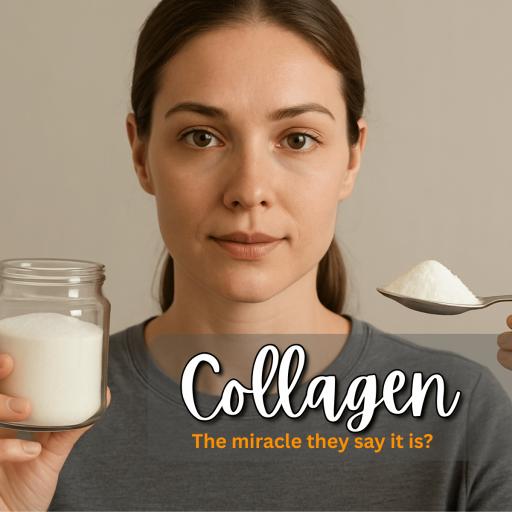Collagen Facts
Sorting through the noise

Let's get straight into the science and separate noise from fact about Collagen as a nutritional supplement.
Collagen is the most abundant protein in the human body, making up nearly one-third of total protein content. It forms the structural framework of connective tissues such as skin, tendons, ligaments, cartilage, and bones. The word "collagen" comes from the Greek "kolla," meaning glue, because it literally helps hold the body together. As we age, collagen synthesis naturally slows, leading to wrinkles, reduced elasticity, joint stiffness, and slower recovery from injury. Understanding the biology of collagen and ways to support it is valuable for long-term health and function.
The Science of Collagen
Protein Structure: Collagen is composed of three polypeptide chains wound into a triple helix, stabilized by hydroxyproline and glycine residues. This configuration provides both tensile strength and flexibility.
Amino Acid Profile: Collagen is rich in glycine, proline, and hydroxyproline—amino acids not always abundant in other dietary proteins.
Cross-Linking: Enzymatic cross-links between collagen fibrils provide additional durability and resistance against mechanical stress.
Physiological Roles
Skin: Collagen maintains dermal structure and elasticity. Reduced collagen leads to wrinkles and sagging.
Bones: Approximately 90% of organic bone mass is collagen, providing scaffolding for mineral deposition.
Joints: Collagen cushions cartilage and absorbs shock. Depletion contributes to osteoarthritis.
Blood Vessels: Type III collagen supports elasticity and structural stability of vascular tissue.
Healing: Collagen is rapidly produced during wound repair and tissue regeneration.
Types of Collagen
Factors Affecting Collagen
Aging: Production declines by roughly 1% per year after the mid-20s.
UV Exposure: Sunlight damages collagen fibers, accelerating skin aging.
Oxidative Stress: Free radicals degrade collagen and impair synthesis.
Lifestyle: Smoking and excessive alcohol accelerate collagen breakdown.
Hormones: Estrogen supports collagen; levels drop during menopause, increasing skin and bone issues.
Nutrients That Support Collagen
Vitamin C: Essential cofactor for hydroxylation of proline and lysine, critical to triple helix stability.
Protein Sources: Bone broth, fish skin, and animal connective tissue supply collagen peptides.
Minerals: Zinc and copper participate in enzymatic reactions for cross-linking.
Plant Compounds: Anthocyanins in berries may protect collagen against breakdown by inhibiting enzymes like collagenase.
Collagen and Metabolism
While collagen itself is not a complete protein (lacking tryptophan), its high glycine content supports detoxification, neurotransmitter synthesis, and creatine production. Collagen turnover is part of the broader protein economy of the body, and maintaining collagen balance influences whole-body metabolism, bone remodeling, and recovery capacity.
Key Takeaway
Collagen is more than just a beauty protein. It is a structural and functional backbone for the body, connecting skin, bones, joints, and organs. Supporting collagen through nutrition, smart supplementation, and lifestyle can preserve resilience, improve performance, and slow visible aging.
Collagen is the most abundant protein in the human body, making up nearly one-third of total protein content. It forms the structural framework of connective tissues such as skin, tendons, ligaments, cartilage, and bones. The word "collagen" comes from the Greek "kolla," meaning glue, because it literally helps hold the body together. As we age, collagen synthesis naturally slows, leading to wrinkles, reduced elasticity, joint stiffness, and slower recovery from injury. Understanding the biology of collagen and ways to support it is valuable for long-term health and function.
The Science of Collagen
Protein Structure: Collagen is composed of three polypeptide chains wound into a triple helix, stabilized by hydroxyproline and glycine residues. This configuration provides both tensile strength and flexibility.
Amino Acid Profile: Collagen is rich in glycine, proline, and hydroxyproline—amino acids not always abundant in other dietary proteins.
Cross-Linking: Enzymatic cross-links between collagen fibrils provide additional durability and resistance against mechanical stress.
Physiological Roles
Skin: Collagen maintains dermal structure and elasticity. Reduced collagen leads to wrinkles and sagging.
Bones: Approximately 90% of organic bone mass is collagen, providing scaffolding for mineral deposition.
Joints: Collagen cushions cartilage and absorbs shock. Depletion contributes to osteoarthritis.
Blood Vessels: Type III collagen supports elasticity and structural stability of vascular tissue.
Healing: Collagen is rapidly produced during wound repair and tissue regeneration.
Types of Collagen
| Type | Where Found | Primary Role |
|---|---|---|
| I | Skin, bone, tendons | Strength, structure, scar tissue |
| II | Cartilage | Joint cushioning, resilience |
| III | Skin, muscles, vessels | Elasticity and pliability |
| IV | Basement membranes | Filtration and boundary support |
| V | Hair, cornea, placenta | Fine tissue formation |
Factors Affecting Collagen
Aging: Production declines by roughly 1% per year after the mid-20s.
UV Exposure: Sunlight damages collagen fibers, accelerating skin aging.
Oxidative Stress: Free radicals degrade collagen and impair synthesis.
Lifestyle: Smoking and excessive alcohol accelerate collagen breakdown.
Hormones: Estrogen supports collagen; levels drop during menopause, increasing skin and bone issues.
Nutrients That Support Collagen
Vitamin C: Essential cofactor for hydroxylation of proline and lysine, critical to triple helix stability.
Protein Sources: Bone broth, fish skin, and animal connective tissue supply collagen peptides.
Minerals: Zinc and copper participate in enzymatic reactions for cross-linking.
Plant Compounds: Anthocyanins in berries may protect collagen against breakdown by inhibiting enzymes like collagenase.
Scientific Evidence: Studies show hydrolyzed collagen peptides may reduce joint discomfort in athletes and older adults, improve skin hydration, and even enhance bone density. Supplementation is often most effective when combined with resistance training and vitamin C intake. For exercise-based nutrition strategies that complement collagen support, visit TACTICAL.
Collagen and Metabolism
While collagen itself is not a complete protein (lacking tryptophan), its high glycine content supports detoxification, neurotransmitter synthesis, and creatine production. Collagen turnover is part of the broader protein economy of the body, and maintaining collagen balance influences whole-body metabolism, bone remodeling, and recovery capacity.
Key Takeaway
Collagen is more than just a beauty protein. It is a structural and functional backbone for the body, connecting skin, bones, joints, and organs. Supporting collagen through nutrition, smart supplementation, and lifestyle can preserve resilience, improve performance, and slow visible aging.
Updated: August 26, 2025 13:02
Category: Nutrition
Keywords: collagen supplements
Comments
You must log in to post a comment.